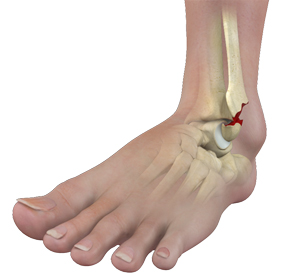
What is an Ankle Fracture?
Ankle injuries are very common in athletes and individuals performing physical work; often resulting in severe pain and impaired mobility. Pain after ankle injuries can either be from a torn ligament (ankle sprain) or broken bone (ankle fracture).
An ankle fracture is a painful condition where there is a break in one or more bones forming the ankle joint. The ankle joint is stabilized by different ligaments and other soft tissues, which may also be injured during an ankle fracture.
What is the Normal Ankle Anatomy?
The ankle joint is composed of three bones: the tibia, fibula, and talus, which articulate together. The ends of the fibula and tibia (lower leg bones) form the inner and outer malleolus, which are the bony protrusions of the ankle joint that you can feel and see on either side of the ankle. The joint is protected by a fibrous membrane called a joint capsule and filled with synovial fluid to enable smooth movement.
What are the Common Causes of Ankle Fractures?
Ankle fractures can occur from excessive rolling and twisting of the ankle - usually from an accident or activities such as jumping or falling, which cause sudden stress to the joint.
What are the Symptoms of an Ankle Fracture?
With an ankle fracture, there is immediate swelling and pain around the ankle as well as impaired mobility. In some cases, blood may accumulate around the joint - a condition called hemarthrosis. In the case of a severe fracture, deformity around the ankle joint is clearly visible where a bone may protrude out piercing the skin.
What are the Types of Ankle Fractures?
Ankle fractures are classified according to their location. The different types of ankle fractures are:
- Lateral malleolus fracture, in which the lateral malleolus, the outer part of the ankle, is fractured
- Medial malleolus fracture, in which the medial malleolus, the inner part of the ankle, is fractured
- Posterior malleolus fracture, in which the posterior malleolus is fractured
- Bimalleolar fractures, in which both the lateral and medial malleolus bones are fractured
- Trimalleolar fractures, in which all three lateral, medial and posterior malleolus bones are fractured
How is an Ankle Fracture Diagnosed?
The diagnosis of an ankle injury begins with a review of your history and a thorough physical examination. This is followed by X-rays of the injured area to visualize the break in the bone.
In some cases, pressure is applied on the ankle and then special X-rays are taken. This procedure is called a stress test. This test is ordered to determine the stability of the fracture under stress and decide on the need for surgery. In certain cases, a CT scan may be needed to further assess the broken bone fragments. In complex cases where a detailed evaluation of the ligaments is required, an MRI scan may be recommended.
What are the Treatment Options for Ankle Fractures?
Immediately following an ankle injury and prior to seeing a doctor, you should apply ice packs and keep the foot elevated to minimize pain and swelling. The treatment of an ankle fracture depends upon the type and the stability of the fractured bone. Treatment starts with non-surgical methods, but in cases where the fracture is unstable and cannot be realigned, surgical methods are employed.
For non-surgical treatment, the ankle bone is realigned and a special splint or a boot is placed around the joint to allow the bones to heal.
With surgical treatment, the fractured bone is accessed by making an incision over the ankle area and the broken bones are visualized and put back in place and held together by a combination of plates and/or screws. The incision is then sutured closed and the operated ankle is immobilized with a splint.
What is the Postoperative Care for an Ankle Fracture?
Immediately after ankle surgery, you will be instructed to keep the foot elevated and use ice to minimize post-operative swelling. You will need to avoid applying weight on the ankle and use crutches while mobilizing for at least six weeks.
Physical therapy of the ankle joint may be recommended by your doctor. The rehab course and length of time you must stay off your ankle will be determined by your surgeon based on the severity of the injury.
What are the Risks and Complications of an Ankle Fracture Treatment?
The risks and complications that can occur following ankle fracture surgery include infection, damage to the nerves or blood vessels, problems with wound healing, as well as failure of the bone to heal properly resulting in a non-union or malunion. Arthritis may also develop over time as a consequence of the initial injury or improper healing of the bone. Further surgery may be necessary to address these complications.





